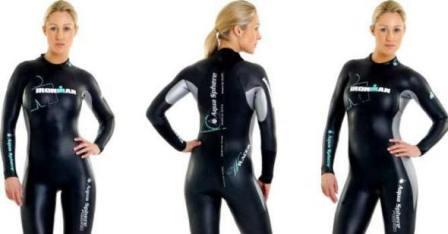Home › Diving Guide › Scuba Equipment › Wetsuits
Scuba Diving Exposure Suits
Divers wear exposure suits in almost all scuba activities. They reduce heat loss and help to protect from minor scrapes, stings, and abrasions.
Body Suits vs. Scuba Wetsuits?
Three basic styles offer differing characteristics.
Depending on how much exposure protection you need, you might choose a body suit, a wet suit, or a dry suit.
When purchasing an exposure suit, you need to consider fit, comfort and thermal protection.
As you dive deeper, wet suits lose buoyancy and insulation properties.
Usually made from colorful Lycra, nylon, or similar material, body suits provide full-length abrasion and sunburn protection.
Divers wear them in tropical waters because they do not insulate effectively. You may also use a body suit to help you to slide into a wet suit more easily and for extra warmth. Body suits fit your figure closely, and you can get them in bright colors and patterns.
Wet Suits
Scuba wet suits are by far the most common form of exposure suit. You can get them in many styles, patterns, and thicknesses, making them suitable for insulation in water as cold as 10 degrees to as warm as 30 degrees Celsius.
 Wet suits reduce heat loss by putting a layer of insulating foam neoprene over your skin. Wet suits get their name because you get wet while wearing them.
Wet suits reduce heat loss by putting a layer of insulating foam neoprene over your skin. Wet suits get their name because you get wet while wearing them.
Water enters at the wrists, ankles, and the neck. The neoprene suit traps water between your skin and the suit.
Your body quickly heats the water, and as long as it remains trapped, you only lose heat as it radiates slowly through the wet suit material.
However, if water circulates in and out of your suit, you lose a lot of heat to incoming cold water.
This is the main reason why wet suits have to be a snug fit. You can get wet suits in many different colors that match the rest of your scuba kit.
Scuba wet suits are worn by divers mainly to help them preserve body heat when diving underwater. By trapping a thin layer of water between the wet-suit and the skin, it should have a snug fit to work properly because a loose fitting wetsuit allows water to escape, taking the divers’ natural warmth from his body with it.
Water can conduct heat away from a divers' body around 25 times more than air, therefore an unprotected diver can suffer hypothermia even in relatively warm water on a hot day.
Wet suits are generally made from foam neoprene, which is a synthetic rubber containing small bubbles of nitrogen gas. Diving wet suits are commonly available in many different brands, styles, sizes and colors although the most popular color is black.
With varying thicknesses from 3mm to 7mm, wetsuits are worn for their thermal protection underwater and our scuba wetsuit temperature guide shows how the thickness directly relates to its thermal qualities.
General Wetsuit Temperature Chart; (Fahrenheit)
- 1 - 3mm is suitable for water temperatures of 65 to 80
- 4 - 5mm is suitable for water temperatures of 60 to 70
- 6 - 7mm is suitable for water temperatures of 50 to 60
- A Dry suit is suitable for water temperatures of 30 to 50
Drysuits are worn by divers who are diving in very cold water and especially when Ice Diving. The garment is filled with air around the body which protects the diver from the risk of severe hypothermia.
Water tight seals around the neck, cuffs and ankles help to retain the warm dry air that insulates the diver underwater.
The buoyancy characteristics of a dry suit behave very differently to wetsuits which is why cold water divers should obtain a confined water orientation to diving in a dry suit prior to making any dives in an open water environment. The PADI Dry Suit Specialty Course is ideal for this purpose.
Wetsuits help to preserve body heat by trapping a layer of water against the skin. This water is consequently warmed by body heat and acts as an insulator.
Water conducts heat away from the body approximately 25 times more efficiently than air, so an unprotected scuba diver can suffer from hypothermia even in warm water on a warm day.
Wet suits are made out of closed-cell, foam neoprene, a synthetic rubber that contains small bubbles of nitrogen gas when made for use as wet-suit material. Diving wetsuits are available in many different colors, the most popular being black.
The thickness of a scuba wetsuit varies from 3mm to 7mm, depending on the temperature of the water and the 'natural' insulation that the diver may have.
Wetsuit Tip
A wetsuit must have a snug fit to work efficiently. A fit that's too loose will allow water to escape from between the suit and the body, taking the body's heat with it.